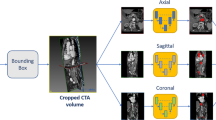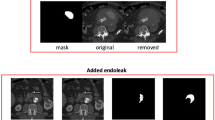Abstract
Purpose
Fusion of preoperative data with intraoperative X-ray images has proven the potential to reduce radiation exposure and contrast agent, especially for complex endovascular aortic repair (EVAR). Due to patient movement and introduced devices that deform the vasculature, the fusion can become inaccurate. This is usually detected by comparing the preoperative information with the contrasted vessel. To avoid repeated use of iodine, comparison with an implanted stent can be used to adjust the fusion. However, detecting the stent automatically without the use of contrast is challenging as only thin stent wires are visible.
Method
We propose a fast, learning-based method to segment aortic stents in single uncontrasted X-ray images. To this end, we employ a fully convolutional network with residual units. Additionally, we investigate whether incorporation of prior knowledge improves the segmentation.
Results
We use 36 X-ray images acquired during EVAR for training and evaluate the segmentation on 27 additional images. We achieve a Dice coefficient of 0.933 (AUC 0.996) when using X-ray alone, and 0.918 (AUC 0.993) and 0.888 (AUC 0.99) when adding the preoperative model, and information about the expected wire width, respectively.
Conclusion
The proposed method is fully automatic, fast and segments aortic stent grafts in fluoroscopic images with high accuracy. The quality and performance of the segmentation will allow for an intraoperative comparison with the preoperative information to assess the accuracy of the fusion.







Similar content being viewed by others
References
Akeret J, Chang C, Lucchi A, Refregier A (2017) Radio frequency interference mitigation using deep convolutional neural networks. Astron Comput 18:35–39
Ambrosini P, Ruijters D, Niessen WJ, Moelker A, van Walsum T (2017) Fully automatic and real-time catheter segmentation in X-ray fluoroscopy. In: Proceedings of the 20th international conference on medical image computing and computer-assisted intervention—MICCAI 2017, part II, pp 577–585
Baur C, Albarqouni S, Demirci S, Navab N, Fallavollita P (2016) Cathnets: detection and single-view depth prediction of catheter electrodes. In: Proceedings of the 7th international conference on medical imaging and augmented reality, MIAR 2016, pp 38–49
Bismuth V, Vaillant R, Funck F, Guillard N, Najman L (2011) A comprehensive study of stent visualization enhancement in X-ray images by image processing means. Med Image Anal 15(4):565–76
Chen T, Wang Y, Durlak P, Comaniciu D (2012) Real time assistance for stent positioning and assessment by self-initialized tracking. In: Proceedings of the 15th international conference on medical image computing and computer-assisted intervention—MICCAI 2012, part I, Berlin, Heidelberg, pp 405–413
Demirci S, Bigdelou A, Wang L, Wachinger C, Baust M, Tibrewal R, Ghotbi R, Eckstein H, Navab N (2011) 3D stent recovery from one X-ray projection. In: Proceedings of the 13th international conference on medical image computing and computer assisted intervention (MICCAI), pp 178–185
Frangi AF, Niessen WJ, Vincken KL, Viergever MA (1998) Multiscale vessel enhancement filtering. In: Proceedings of the first international conference on medical image computing and computer-assisted interventation—MICCAI’98, pp 130–137
Gindre J, Bel-Brunon A, Rochette M, Lucas A, Kaladji A, Haigron P, Combescure A (2017) Patient-specific finite-element simulation of the insertion of guidewire during an EVAR procedure: guidewire position prediction validation on 28 cases. IEEE Trans Biomed Eng 64(5):1057–66
He K, Zhang X, Ren S, Sun J (2015) Deep residual learning for image recognition. arXiv:1512.03385
Hertault A, Maurel B, Sobocinski J, Gonzalez TM, Roux ML, Azzaoui R, Midulla M, Haulon S (2014) Impact of hybrid rooms with image fusion on radiation exposure during endovascular aortic repair. Eur J Vasc Endovasc Surg 48(4):382–90
Hoffmann M, Brost A, Koch M, Bourier F, Maier A, Kurzidim K, Strobel N, Hornegger J (2015) Electrophysiology catheter detection and reconstruction from two views in fluoroscopic images. IEEE Trans Med Imaging 35(2):567–79
Ioffe S, Szegedy C (2015) Batch normalization: accelerating deep network training by reducing internal covariate shift. arXiv:1502.03167
Kauffmann C, Douane F, Therasse E, Lessard S, Elkouri S, Gilbert P, Beaudoin N, Pfister M, Blair JF, Soulez G (2015) Source of errors and accuracy of a two-dimensional/three-dimensional fusion road map for endovascular aneurysm repair of abdominal aortic aneurysm. J Vasc Intervent Radiol 26(4):544–51
Klein A, van der Vliet JA, Oostveen LJ, Hoogeveen Y, Kool LJS, Renema WKJ, Slump CH (2012) Automatic segmentation of the wire frame of stent grafts from CT data. Med Image Anal 16(1):127–39
Lessard S, Kauffmann C, Pfister M, Cloutier G, Therasse E, de Guise JA, Soulez G (2015) Automatic detection of selective arterial devices for advanced visualization during abdominal aortic aneurysm endovascular repair. Med Eng Phys 37(10):979–86
Long J, Shelhamer E, Darrell T (2015) Fully convolutional networks for semantic segmentation. In: Proceedings CVPR, pp 3431–40
McNally MM, Scali ST, Feezor RJ, Neal D, Huber TS, Beck AW (2015) Three-dimensional fusion computed tomography decreases radiation exposure, procedure time, and contrast use during fenestrated endovascular aortic repair. J Vasc Surg 61(2):309–16
Milletari F, Navab N, Ahmadi SA (2016) V-net: Fully convolutional neural networks for volumetric medical image segmentation. In: IEEE international conference on 3D vision, pp 565–71
Odena A, Dumoulin V, Olah C (2016) Deconvolution and checkerboard artifacts. Distill 1:e3 http://distill.pub/2016/deconv-checkerboard/
Panuccio G, Federico Torsello G, Pfister M, Bisdas T, Bosiers M, Torsello G, Austermann M (2016) Computer-aided endovascular aortic repair using fully automated two- and three-dimensional fusion imaging. J Vasc Surg 6(64):1587–94
Reiml S, Pfister M, Toth D, Maier A, Hoffmann M, Kowarschik M, Hornegger J (2015) Automatic detection of stent graft markers in 2-D fluoroscopy images. In: Joint MICCAI workshop on computing and visualisation for intravascular imaging and computer-assisted stenting, pp 34–41
Ronneberger O, Fischer P, Brox T (2015) U-Net: convolutional networks for biomedical image segmentation. In: Proceedings of the 18th medical image computing and computer-assisted intervention—MICCAI 2015, part III, pp 234–241
Schulz CJ, Schmitt M, Bckler D, Geisbsch P (2016) Fusion imaging to support endovascular aneurysm repair using 3D–3D registration. J Endovasc Ther 23(5):791–99
Springenberg JT, Dosovitskiy A, Brox T, Riedmiller MA (2014) Striving for simplicity: the all convolutional net. arXiv:1412.6806
Tacher V, Lin M, Desgranges P, Deux JF, Grünhagen T, Becquemin JP, Luciani A, Rahmouni A, Kobeiter H (2013) Image guidance for endovascular repair of complex aortic aneurysms: comparison of two-dimensional and three-dimensional angiography and image fusion. J Vasc Intervent Radiol 24(11):1698–706
Toth D, Pfister M, Maier A, Kowarschik M, Hornegger J (2015) Adaption of 3D models to 2D X-ray images during endovascular abdominal aneurysm repair. In: Proceedings of the 18th international conference on medical image computing and computer-assisted intervention—MICCAI 2015, part I, pp 339–46
Volpi D, Sarhan MH, Ghotbi R, Navab N, Mateus D, Demirci S (2015) Online tracking of interventional devices for endovascular aortic repair. Int J Comput Assist Radiol Surg 10(6):773–81
Author information
Authors and Affiliations
Corresponding author
Ethics declarations
Conflict of interest
S. Albarqouni and A. Maier have no conflict of interest to declare. K. Breininger is funded by Siemens Healthcare GmbH. T. Kurzendorfer, M. Pfister, and M. Kowarschik are employees of Siemens Healthcare GmbH.
Ethical approval
This study has been performed retrospectively. For this type of study formal consent is not required.
Informed consent
Informed consent was obtained from all individual participants included in the original study.
Additional information
Disclaimer: The methods and information presented in this work are based on research and are not commercially available.
Rights and permissions
About this article
Cite this article
Breininger, K., Albarqouni, S., Kurzendorfer, T. et al. Intraoperative stent segmentation in X-ray fluoroscopy for endovascular aortic repair. Int J CARS 13, 1221–1231 (2018). https://doi.org/10.1007/s11548-018-1779-6
Received:
Accepted:
Published:
Issue Date:
DOI: https://doi.org/10.1007/s11548-018-1779-6




